Resellos on dos caritas - Sonora
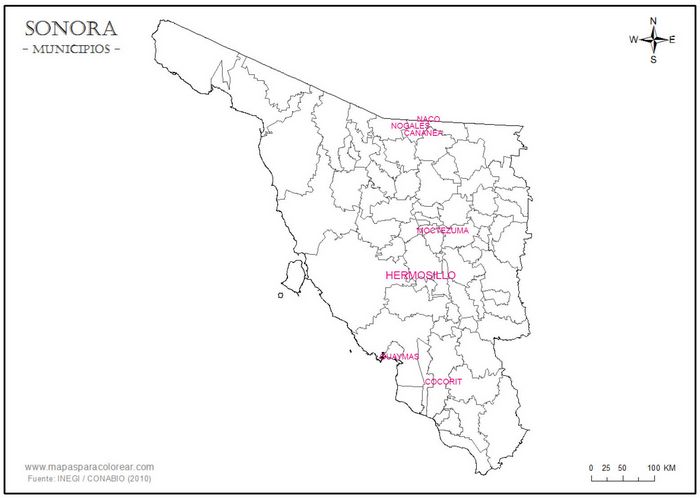
Villa’s agents in El Paso sent the governor of Sonora, José María Maytorena, Villista currency, with the aim of withdrawing from circulation the Carrancista notes that were most commonly being usedPrensa, 1 October 1914. On 23 September 1914 $500,000 was received at NogalesEl Paso Herald, 23 September 1914: El Paso Morning Times, 24 September 1914: San Antonio Express, 24 September 1914. In February 1915 the Agencia Comercial y Financiera del Cuerpo de Ejército del Norte, under instruction from Villa, sent one million pesos in Chihuahua paper currency via Wells Express from Ciudad Juárez to Nogales $100,000 on 9 February, $100,000 on 10 February, $720,000 and $80,000 on 26 February. JMM papers, box 5, folder 2, item 24. On 23 March the Tesorería General of Sonora was sent $300,000.00 in dos caritas, and on 29 April another $500,000AGHES, Fondo Oficialidad Mayor, tomo 3024. However, these remittances to an ally became increasingly difficult: “Real money is the cause of Maytorena’s fall from grace, as funds in his army have been exceedingly short for months past. A soldier’s pay at this time is hardly sufficient to secure one meal, to say nothing of clothing and other supplies. A remittance from General Villa has been expected, but a short message received here from Juarez stated that there would be no funds available for the Sonora campaign and that the governor must provide himself with money from some other sourceDouglas Daily Dispatch, 21 April 1915, though there was the consignment on 29 April”.
On 11 February 1915 Maytorena, in Nogales, issued circular núm. 1 with instructions for customs officials. Everyone entering the country was to be asked if they were bringing in paper currency. If the person answered no, they were to be allowed to pass, unless the official suspected they were lying: in which case they were to be searched. If they were found to be carrying legitimate currency, it was to be confiscated: if they were found to be carrying any counterfeit notes they were to be consigned to the nearest political authority. Whenever anyone handed in currency for inspection, it was to be checked by the official. Good notes were to be returned, marked with the official’s initials, whilst counterfeit notes were to be punch-stamped (with holes at least 1cm in diameter) through the serial numbers, stamped FALSO in indelible ink and returned. Circular núm. 2, of 12 February 1915, laid down similar regulations for shipping agents such as Wells Fargo and CompanyAGHES, Fondo Oficialidad Mayor, tomo 3024.
The Sonoran government, with the help of the Treasury General of Chihuahua, established an office in charge of inspecting and revalidating notes. Most of the correspondence dates from April and May 1915: this might just be fortuitous but as those resellos with dates also come from this period it seems that the authorities did not take matters particularly seriously until large numbers of counterfeit Chihuahua notes started appearing along the border.
The various officials working in the department included:
 Remigio Montoya: Montoya worked in Nogales. He had been sent by the Tesoreria General in Chihuahua but on 11 March 1915 Maytorena requested a replacement because Montoya had been arrested after being found restamping and signing a quantity of notes in his own roomJMM papers, box 5, folder 3, item 15, José Maytorena to Gob. del Estado (Chihuahua), 11 March 1915. Montoya was caught, with his accomplices, stamping $50,000 in dubious $20 dos caritasJMM papers, box 5, folder 3, item 6, letter José Maytorena to Escudero, Chihuahua, 12 March 1915. The Los Angeles Times claimed that the counterfeit paper currency taken in at Nogales, amounting to about $500,000 in face value, was carefully saved, and that it was taken to Tucson by the currency expert himself, who spent about ten nights busily rubber-stamping all of it as genuine. His mysterious operations were reported to the Sheriff, who raided the room, and found not only the expert and his rubber stamps, but several prominent residents of Sonora. It was claimed that no less than twenty-eight Mexican officials had been implicated by an investigation set on foot by Maytorena and that most of them had fled to the United StatesBisbee Daily Review, 19 March 1915; Los Angeles Times, 29 March 1915. Chihuahua sent Francisco Porras as a replacementJMM papers, box 5, folder 3, item 21 Vargas to Maytorena, 13 March 1915 and Villa himself, from Torreón, ordered that if Montoya was found guilty he should be severely punished pour encourager les autresJMM papers, box 5, folder 3, Escudero to Maytorena, 13 March 1915. However, Montoya seems to have been absolved, one way or another, because by April Vargas confirmed that one of the $20 Serie E notes that Montoya remitted was legitimateJMM papers, box 5, folder 6 letter J. J. Goodman & Co., Nogales to Maytorena, 22 April 1915. Ironically, a newspaper reported that James Goodman, an American, and twenty-two other Americans were arrested in Nogales, Sonora on charges of circulating counterfeit Mexican currency. $100,000 in Mexican currency was taken from the prisoners (El Paso Herald, 13 March 1915). An more likely report has Goodman, two Spaniards and 22 Mexicans (Duluth News, 13 March 1915) and by 9 May Montoya was working in Guaymas. The Prefecto Municipal asked Maytorena to let him stay a couple of days longer to revalidate the billetes de firma (sábanas?) which Rivas had been unable to recogniseJMM papers, box 5, folder 9, telegram Presidente Municipal Escalente to Maytorena, 9 May 1915.
Remigio Montoya: Montoya worked in Nogales. He had been sent by the Tesoreria General in Chihuahua but on 11 March 1915 Maytorena requested a replacement because Montoya had been arrested after being found restamping and signing a quantity of notes in his own roomJMM papers, box 5, folder 3, item 15, José Maytorena to Gob. del Estado (Chihuahua), 11 March 1915. Montoya was caught, with his accomplices, stamping $50,000 in dubious $20 dos caritasJMM papers, box 5, folder 3, item 6, letter José Maytorena to Escudero, Chihuahua, 12 March 1915. The Los Angeles Times claimed that the counterfeit paper currency taken in at Nogales, amounting to about $500,000 in face value, was carefully saved, and that it was taken to Tucson by the currency expert himself, who spent about ten nights busily rubber-stamping all of it as genuine. His mysterious operations were reported to the Sheriff, who raided the room, and found not only the expert and his rubber stamps, but several prominent residents of Sonora. It was claimed that no less than twenty-eight Mexican officials had been implicated by an investigation set on foot by Maytorena and that most of them had fled to the United StatesBisbee Daily Review, 19 March 1915; Los Angeles Times, 29 March 1915. Chihuahua sent Francisco Porras as a replacementJMM papers, box 5, folder 3, item 21 Vargas to Maytorena, 13 March 1915 and Villa himself, from Torreón, ordered that if Montoya was found guilty he should be severely punished pour encourager les autresJMM papers, box 5, folder 3, Escudero to Maytorena, 13 March 1915. However, Montoya seems to have been absolved, one way or another, because by April Vargas confirmed that one of the $20 Serie E notes that Montoya remitted was legitimateJMM papers, box 5, folder 6 letter J. J. Goodman & Co., Nogales to Maytorena, 22 April 1915. Ironically, a newspaper reported that James Goodman, an American, and twenty-two other Americans were arrested in Nogales, Sonora on charges of circulating counterfeit Mexican currency. $100,000 in Mexican currency was taken from the prisoners (El Paso Herald, 13 March 1915). An more likely report has Goodman, two Spaniards and 22 Mexicans (Duluth News, 13 March 1915) and by 9 May Montoya was working in Guaymas. The Prefecto Municipal asked Maytorena to let him stay a couple of days longer to revalidate the billetes de firma (sábanas?) which Rivas had been unable to recogniseJMM papers, box 5, folder 9, telegram Presidente Municipal Escalente to Maytorena, 9 May 1915.
 Francisco J. Cabezud: was the inspector in Nogales. He started on 12 March 1915ABCS, Gobernación, vol. 642, exp. 150 and resigned his post, on taking up another commission, on 29 May 1915. During his tenure he revalidated $1,387,631 ($166,800 in March, $714,196 in April and $506,635 in MayJMM papers, box 5, folder 12, letter Cabezud to Maytorena, 26 May 1915, including some one peso sábanas (or possibly dos caritas).
Francisco J. Cabezud: was the inspector in Nogales. He started on 12 March 1915ABCS, Gobernación, vol. 642, exp. 150 and resigned his post, on taking up another commission, on 29 May 1915. During his tenure he revalidated $1,387,631 ($166,800 in March, $714,196 in April and $506,635 in MayJMM papers, box 5, folder 12, letter Cabezud to Maytorena, 26 May 1915, including some one peso sábanas (or possibly dos caritas).
Ramón. D. Gamelon: worked as an assistant to Cabezud (Ayudante del Revisador de Papel Moneda) in Nogales but resigned in 15 May 1915 to go to La Paz, Baja California for family reasonsJMM papers, box 5, folder 10, item 42.
Daniel. R. Aguilar: took over from Gamelon as an assistant to Cabezud on 19 May 1915, on a monthly salary of $100JMM papers, box 5, folder 11, letter Maytorena to Cabezud, 19 May 1915.
José P. González: was the inspector in Cananea. González worked for the Tesorería General in Chihuahua. Sebastian Vargas, hijo, the Chihuahua Treasurer General, sent González to Sonora in April, asking Maytorena to send him back when his services were no longer required so that he could be deployed somewhere elseJMM papers, box 6, Vargas to Maytorena, 26 May 1915. González arrived at Nogales on 14 April 1915JMM papers, box 5, folder 6, item 9. On 29 April he was in Naco stamping the various issues of Mexican currency in circulation there. Enrique Acosta, the new customs collector at Naco, said that all currency in circulation had to be brought in for examination. A considerable amount was rejected, but the majority was approved with González’ initials and official stamp. Owing to the fact that the medium of value in Naco was principally the American dollar, González did not have a great deal of work to do. González left on 30 April for CananeaBisbee Daily Review, 30 April 1915. He was in Naco on 2 May, in Cananea by 4 May and there on 20 May. On 25 May the Administrador of the customs at La Morita, Naco again asked for his services and the next week Maytorena replied that he would send him as soon as he was ableJMM papers, box 5, folder 12, 31 May 1915. On 27 May González was instructed to go to Villa Verde to revalidate the pay for the troops thereJMM papers, box 5, folder 12, Maytorena to González, 27 May 1915.
Camilo E. Ortiz: was the inspector in Hermosillo. He was in place by 7 May 1915. Ortiz was making housecalls because on 11 May, together with the Comandante de Policía, he visited Las Fabricas de Francia of H. James y Cia., Sucs. The business had received a large sum of money from a casa comercial in Guadalajara, but each note had been revalidated, some in Nogales and the rest in Guaymas. Some of the notes found had false resellos, and the manager, Agustín Beraud, claimed that these had been given by the Aduana de Nogales to the First National Bank. Beraud also claimed another American had recently deposited $5,000 in billetes resellados that he obtained in Nogales that had turned out to be falseJMM papers, box 5, folder 10, letter 14 May 1915.
 Francisco F. Porras: was the inspector in Guaymas. He was an employee of the Treasury General in Chihuahua and was sent to Sonora in March 1915 to replace Remigio Montoya JMM papers, box 5, folder 3, item 21, Sebastian Vargas to José Maytorena, 13 March 1915. On 17 May he was in Cocorit, and ordered to go to Fundición (halfway between Cocorit and Navajoa) to check the notes thereJMM papers, box 5, folder 11, Maytorena to Porras, 17 May 1915..
Francisco F. Porras: was the inspector in Guaymas. He was an employee of the Treasury General in Chihuahua and was sent to Sonora in March 1915 to replace Remigio Montoya JMM papers, box 5, folder 3, item 21, Sebastian Vargas to José Maytorena, 13 March 1915. On 17 May he was in Cocorit, and ordered to go to Fundición (halfway between Cocorit and Navajoa) to check the notes thereJMM papers, box 5, folder 11, Maytorena to Porras, 17 May 1915..
 A.G. Rivas: was already working in Guaymas when he was appointed on 15 May 1915, on a monthly salary of $300JMM papers, box 5, folder 10, Maytorena to Rivas, 15 May 1915.
A.G. Rivas: was already working in Guaymas when he was appointed on 15 May 1915, on a monthly salary of $300JMM papers, box 5, folder 10, Maytorena to Rivas, 15 May 1915.
On 2 May 1915 the Primer Regidor of Banamichi, A. V. Robles, was asking whether the dos caritas were obligatory without resellos, and asked for permission to revalidate the notes in his townJMM papers, box 5, folder 8, item 6. He was told that they were forced and that only the nominated Inspectors were authorised to revalidate notesJMM papers, box 5, folder 8, item 16 [José Maytorena to Municipal President of Banámichi, 3 May 1915.
Also on 2 May 1915 businesses in Magdalena agreed to send someone to either Nogales or Hermosillo with all the unrevalidated notes, so that only revalidated notes could circulate in the townJMM papers, box 5, folder 8, item 11.
Nogales – Aduana Fronteriza


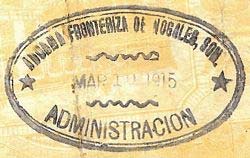 A black 56.5mm oval stamp with ‘ADUANA FRONTERIZA DE NOGALES, SON. - ADMINISTRACION’ and date in centre. Known dates range from 12 February to 11 March 1915 and it was used until 15 MarchRecorded dates are 12, 13, 16, 17, 18 February and 1, 2, 5, 8, 9, 10 and 11 March.
A black 56.5mm oval stamp with ‘ADUANA FRONTERIZA DE NOGALES, SON. - ADMINISTRACION’ and date in centre. Known dates range from 12 February to 11 March 1915 and it was used until 15 MarchRecorded dates are 12, 13, 16, 17, 18 February and 1, 2, 5, 8, 9, 10 and 11 March.
The resello was initialled by Remigio Montoya.
This stamp was used by the customs when they checked currency that had been brought in from the United States. On 20 March 1915 the Sonoran Tesorería General issued instructions to customs officials that everyone bringing in currency had to declare it. Any bona fide currency was to be initialled by the assessor whilst any counterfeit was to be perforated near the serial number, stamped ‘FALSO’ in indelible ink and returned to the owner after asking him whence he obtained it. Any undeclared currency, if good, was to be confiscated whilst undeclared counterfeit currency would render the holder a prima facie counterfeiterAGHES, Fondo Oficialidad Mayor, tomo 3024.
In March 1915 the Los Angeles Times reported on a case of corruption by the government official (Remigio Montoya) employed at the customhouse in Nogales to check all the currency presented. Instead of destroying the counterfeit currency he took in, amounting to about $500,000 in face value, he had carefully saved it and taken it to Tucson, where he had spent about ten nights in busily rubber-stamping all of it as genuine. His mysterious operations were reported to the Sheriff, who raided the room, and found not only the expert and his rubber stamps, but several prominent residents of Sonora. It was claimed that no less than twenty-eight Mexican officials had been implicated by an investigation set on foot by Maytorena and that most of them had fled to the United StatesLos Angeles Times, 29 March 1915.
Nogales – Fuerzas del Estado
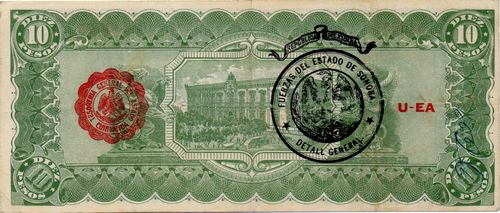
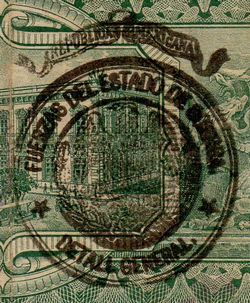
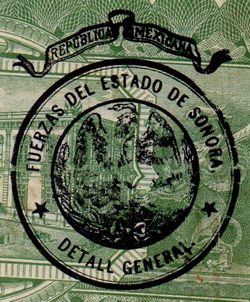
large lettering small lettering
A large 42mm round black stamp with eagle in centre and ‘FUERZAS DEL ESTADO DE SONORA. - DETALL GENERAL’ around with a ribbon inscribed ‘REPUBLICA MEXICANA’ above.
This was intialled by Francisco J. Cazebud.
This stamp was used in Nogales from March 1915Vida Nueva, 9 March 1915. On 12 March 1915 Governor Maytorena issued a notice informing the public that he had commissioned Cazebud to oversee the revision and revalidation of notes. Therefore notes sealed until the previous day with the “Administración de la Aduana de Nogales, Sonora” and the initials “R. M.” were valid, and henceforth notes would have a “República Mexicana. Fuerzas del Estado de Sonora. Detalle General” seal and the initials “F. J. C.”Prensa, San Antonio, 19 March 1915.
This resello was also counterfeited. On 7 May 1915 Maytorena wrote to the various inspectors (Ortiz, Porras, González, and Cabezud), stating that as the resello was the only guarantee that the public had of authenticity, it was disconcerting and prejudicial to the government when certain inspectors certified that a note was legitimate and then, on second examination, decided it was counterfeit and stamped it accordingly. Maytorena therefore resolved that once a note had been declared genuine by any of the designated inspectors and stamped as such, no other inspector nor even the one who had made the decisión, had the right to restamp the note as false, even if this proved to be the case JMM papers, box 5, folder 9, item 6. On the following day Ortiz asked whether the notes that had a false ‘Detall’ resello and false Cabezud signature, should be stamped FALSO or allowed to circulate as genuine. The reply was that the circular only referred to counterfeit notes that had genuinely revalidated: notes with counterfeit resellos should be marked FALSO JMM papers, box 5, folder 9 telegram Camilo Ortiz to Maytorena, 8 May 1915.
On 10 May 1915 the Tesorero General Interino, J. Ramos, reported from Hermosillo that there was public reluctance to accept notes with the Fuerzas resello and Cabezud’s signature and asked whether they could be revalidated by the inspector in HermosilloJMM papers, box 5, folder 10, item 2 telegram Ramos to Maytorena, 10 May 10 1915.
Nogales – Secretaría Particular
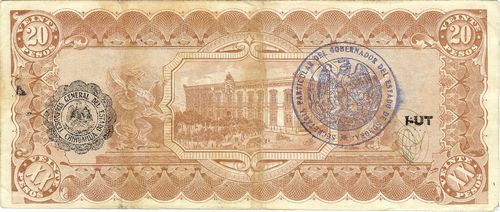
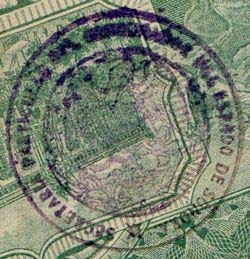 A large (39mm) round seal with eagle in centre and ‘SECRETARIA PARTICULAR DEL GOBERNADOR DEL ESTADO DE SONORA’. This stamp was used with green, blue, violet or black ink.
A large (39mm) round seal with eagle in centre and ‘SECRETARIA PARTICULAR DEL GOBERNADOR DEL ESTADO DE SONORA’. This stamp was used with green, blue, violet or black ink.
This resello was used in Nogales from 28 May 1915 by the inspector, Remigio Montoya, whose initials, 'RM', appear next to the reselloJMM papers, box 5, folder 12 Aviso al Público, 28 May 1915. It would appear that this seal was used not because of any connection with the Secretario Particular but merely because of a shortage of rubber stampsOn 15 May Maytorena wrote to the Agencia Financiera in Ciudad Juárez asking for six rubber stamps reading “Comision Revisadora de Billetes del Estado de Sonora”. JMM papers, box 5, folder 10.
Cananea – Presidencia Municipal
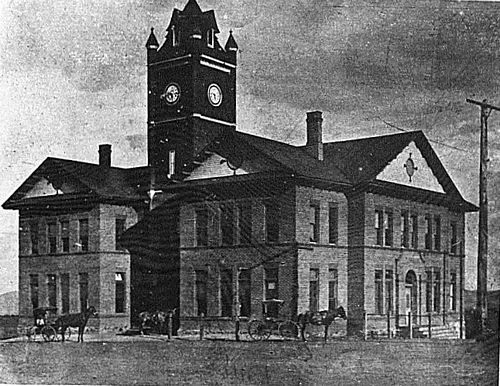
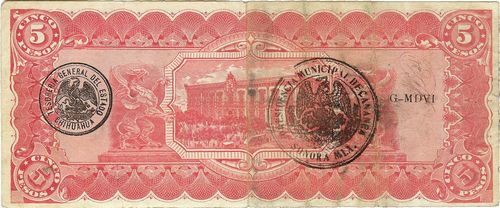
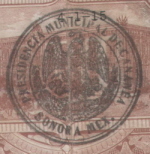 A 41mm round black stamp inscribed ‘PRESIDENCIA MUNICIPAL DE CANANEA - SONORA, MEX.’ with eagle in centre and initials
A 41mm round black stamp inscribed ‘PRESIDENCIA MUNICIPAL DE CANANEA - SONORA, MEX.’ with eagle in centre and initials
The Carrancista Calles captured Cananea on 20 July 1915.
Naco – Aduana Fronteriza
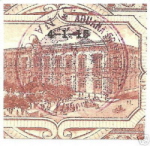 A round seal inscribed ‘ADUANA FRONTERIZA DE LA MORITA NACO SON’ with eagle in centre.
A round seal inscribed ‘ADUANA FRONTERIZA DE LA MORITA NACO SON’ with eagle in centre.
Naco is on the border with Arizona, opposite Bisbee. The custom post used to be at La Morita, a small pueblo a few miles south of the border, and kept this name when it was moved to Naco. Carranza officially renamed the post on 26 June 1914Decree 28 of 26 June 1914 but they must have continued using old stock.
On 29 April 1915 José González, representing the Tesorero General of the state of Chihuahua and a currency expert for the Villa government, spent the day in Naco stamping the various issues of Mexican currency in circulation there. González rejected some but the majority was approved with his initials and official stampBisbee Daily Review, 30 April 1915.
The Carrancista Calles captured Naco on 20 July 1915.
Moctezuma – Ayuntamiento
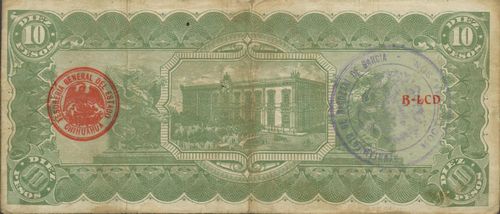
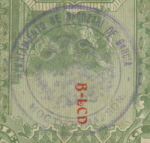 A round 45mm seal with 'AYUNTAMIENTO DE NACOZARI DE GARCIA - MOCTEZUMA SON’ and eagle in centre.
A round 45mm seal with 'AYUNTAMIENTO DE NACOZARI DE GARCIA - MOCTEZUMA SON’ and eagle in centre.
Nacozari de Garcia is a mining town on the road from Agua Prieta to Moctezuma.
Hermosillo – Tesorería General
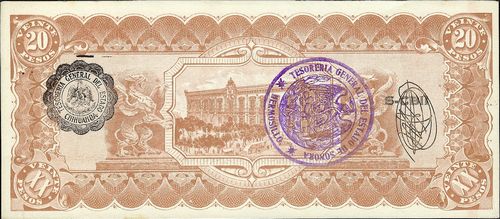
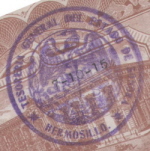 two different size round seals (39mm and 28mm) with ‘TESORERIA GENERAL DEL ESTADO DE SONORA -, HERMOSILLO’ around an eagle. The stamp was used with black and violet ink
two different size round seals (39mm and 28mm) with ‘TESORERIA GENERAL DEL ESTADO DE SONORA -, HERMOSILLO’ around an eagle. The stamp was used with black and violet ink
On 31 March 1915 Louis Hostetter, the American consul in Hermosillo, reported that conditions were such that the looting of stores was liable to take place in Hermosillo as well as in a number of towns in the State. The unrest was caused by the money in circulation. Counterfeit money, especially the two Chihuahua issues, had been brought into the state in large quantities and, although the government knew the facts, a decree was issued making it compulsory to take this money or go to jail. “Villa now sends a man over to examine the money and stamp counterfeit on all bad money. This man has stamped at least one half of the money counterfeit and people have to put up with the loss, many a poor person goes there with from fifty to one hundred pesos, all they have and will receive much less than half back, stamped good. The state treasury has paid out a great deal of this money and refuse to replace the same although it was compulsory to take it or go to jail. One Chinese merchant took twenty hundred pesos for examination and everyone was stamped counterfeit. Employees of the government who received their money from the treasury have to stand their own losses, people claim a large quantity of the money stamped counterfeit is good, but get no satisfaction from the expert. Some of the money which was stamped as good in Nogales is stamped counterfeit here. This has greatly exasperated the people and poor people have not enough to buy provisions with, hence fears of looting”SD papers, 812.5157/74, report Hostetter to State Department, 31 March 1915.
We have records of some consignments of dos caritas to the Tesorería General of Sonora, namely $300,000 on 23 March 1915; $500,000 on 29 April 1915AGHES, Fondo Oficialidad Mayor, tomo 3024. There is no record of whether these notes were revalidated or not.
Guaymas – Aduana Marítima
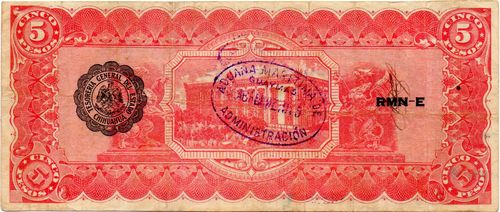
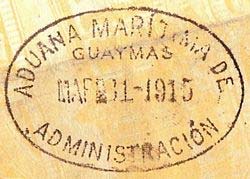 A 44mm blue or violet oval rubber stamp with inscription ‘ADUANA MARITIMA DE GUAYMAS - ADMINISTRACION’ and date in centre. Known dates range from 30 March to 2 May 1915Recorded dates are 30 and 31 March, .
A 44mm blue or violet oval rubber stamp with inscription ‘ADUANA MARITIMA DE GUAYMAS - ADMINISTRACION’ and date in centre. Known dates range from 30 March to 2 May 1915Recorded dates are 30 and 31 March, .
Guaymas is the main port of Sonora, about 150 kilometres south of Hermosillo. It was held by the federal troops under General Telléz until 17 July 1914, when it was captured by the rebels.
These resellos were initialled by Porras or Rivas.
Guaymas – Distrito
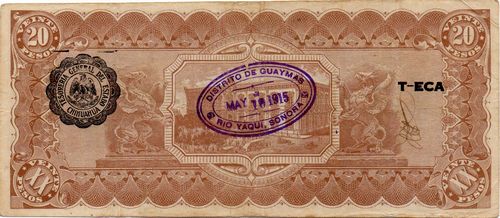
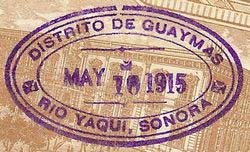 A violet 40mm oval stamp with ‘DISTRITO DE GUAYMAS - RIO YAQUI, SONORA’ and date in centre. Known dates range from 10 May to 25 May 1915Recorded dates are 10, 24, 25 May.
A violet 40mm oval stamp with ‘DISTRITO DE GUAYMAS - RIO YAQUI, SONORA’ and date in centre. Known dates range from 10 May to 25 May 1915Recorded dates are 10, 24, 25 May.
We know that by May 1915 notes were being restamped in the Municipal Treasury in Guaymas so this resello possibly comes from that building.
Cocorit – Tesorería Municipal

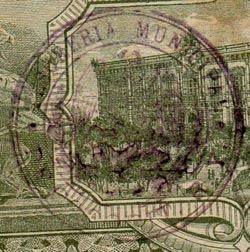 A black 40mm round seal with ‘TESORERIA MUNICIPAL DE COCORIT, R. Y.’ and eagle in centre.
A black 40mm round seal with ‘TESORERIA MUNICIPAL DE COCORIT, R. Y.’ and eagle in centre.
Cocorit is now just a Yaqui settlement on the Rio Yaqui, but during the revolution it was the municipio where the city of Ciudad Obregón was afterwards developed. It was the headquarters for the Prefecto of Guaymas from 19 August 1913 until July 1914, whilst the Huertistas held the port.
